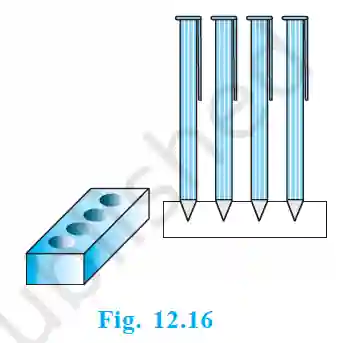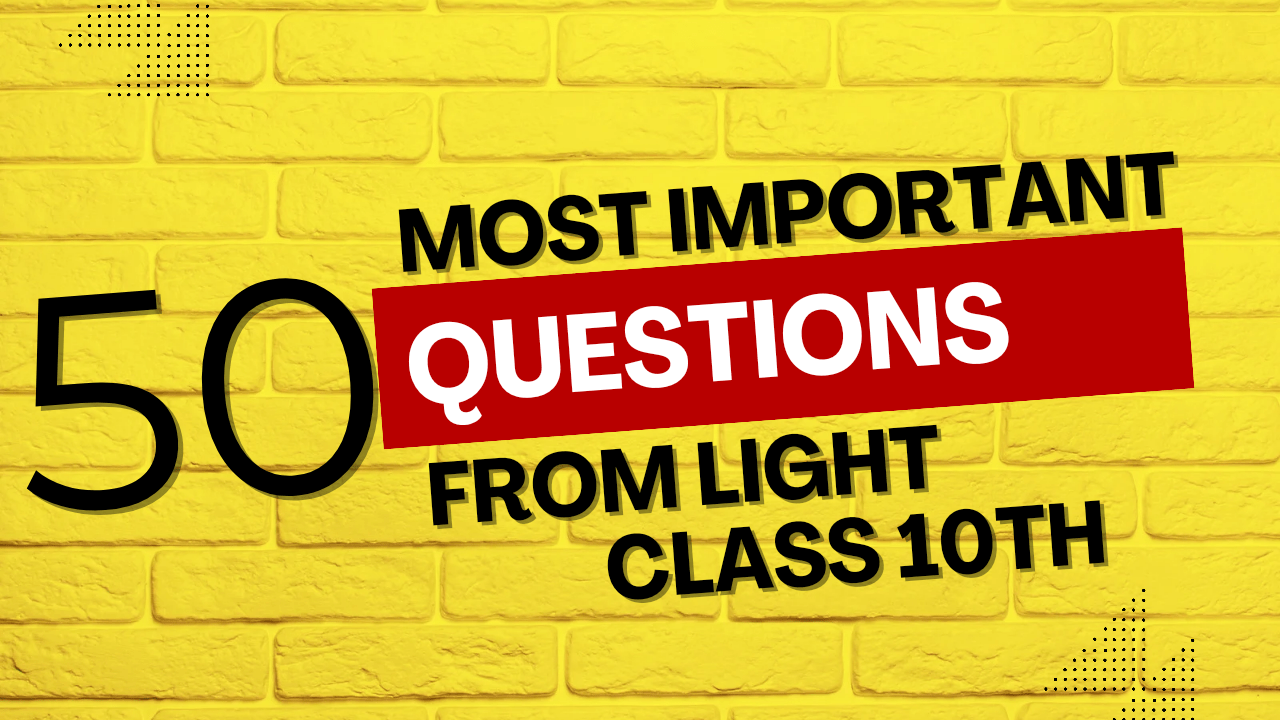Exercise 12.2 Solutions
Surface Areas and Volumes
(Unless stated otherwise, take π = 22/7)
1. A solid is in the shape of a cone standing on a hemisphere with both their radii being equal to 1 cm and the height of the cone is equal to its radius. Find the volume of the solid in terms of π.
Step 1: Identify dimensions.
Radius (r) = 1 cm.
Height of cone (h) = radius = 1 cm.
Step 2: Determine the formula for the volume.
Total Volume = (Volume of Cone) + (Volume of Hemisphere)
= (1/3)πr²h + (2/3)πr³
Step 3: Calculate the volume.
= (1/3)π(1)²(1) + (2/3)π(1)³
= (1/3)π + (2/3)π = (3/3)π = π cm³.
Answer: The volume of the solid is π cm³.
2. Rachel, an engineering student, was asked to make a model shaped like a cylinder with two cones attached at its two ends by using a thin aluminium sheet. The diameter of the model is 3 cm and its length is 12 cm. If each cone has a height of 2 cm, find the volume of air contained in the model.
Step 1: Identify dimensions.
Diameter = 3 cm, so radius (r) = 1.5 cm.
Total length = 12 cm.
Height of each cone (hcone) = 2 cm.
Height of cylinder (hcyl) = Total length – 2 × (height of cone) = 12 – 2(2) = 8 cm.
Step 2: Determine the formula for the volume.
Total Volume = (Volume of Cylinder) + 2 × (Volume of Cone)
= πr²hcyl + 2 * (1/3)πr²hcone = πr²(hcyl + 2/3 hcone)
Step 3: Calculate the volume.
= (22/7) × (1.5)² × (8 + 2/3 × 2)
= (22/7) × 2.25 × (8 + 4/3)
= (22/7) × 2.25 × (28/3) = 22 × 0.75 × 4 = 66 cm³.
Answer: The volume of air in the model is 66 cm³.
3. A gulab jamun, contains sugar syrup up to about 30% of its volume. Find approximately how much syrup would be found in 45 gulab jamuns, each shaped like a cylinder with two hemispherical ends with length 5 cm and diameter 2.8 cm.
 >
>Step 1: Find the volume of one gulab jamun.
Diameter = 2.8 cm, so radius (r) = 1.4 cm.
Total length = 5 cm.
Length of cylinder (h) = 5 – (2 × 1.4) = 5 – 2.8 = 2.2 cm.
Volume of 1 gulab jamun = (Vol. of Cylinder) + 2 × (Vol. of Hemisphere)
= πr²h + 2 * (2/3)πr³ = πr²(h + 4r/3)
= (22/7) × (1.4)² × (2.2 + 4(1.4)/3)
= (22/7) × 1.96 × (2.2 + 5.6/3) = 6.16 × (6.6+5.6)/3 = 6.16 × 12.2/3 ≈ 25.05 cm³.
Step 2: Find the total volume of 45 gulab jamuns.
Total Volume = 45 × 25.05 ≈ 1127.25 cm³.
Step 3: Find the volume of syrup.
Volume of syrup = 30% of Total Volume = 0.30 × 1127.25 ≈ 338.17 cm³.
Answer: Approximately 338 cm³ of syrup would be found.
4. A pen stand made of wood is in the shape of a cuboid with four conical depressions to hold pens. The dimensions of the cuboid are 15 cm by 10 cm by 3.5 cm. The radius of each of the depressions is 0.5 cm and the depth is 1.4 cm. Find the volume of wood in the entire stand.
 >
>Step 1: Calculate the volume of the cuboid.
Volume of cuboid = l × b × h = 15 × 10 × 3.5 = 525 cm³.
Step 2: Calculate the volume of one conical depression.
Radius (r) = 0.5 cm, Height (h) = 1.4 cm.
Volume of cone = (1/3)πr²h = (1/3) × (22/7) × (0.5)² × 1.4 = 1.1/3 cm³.
Step 3: Calculate the total volume of the four depressions.
Total volume of 4 cones = 4 × (1.1/3) = 4.4/3 ≈ 1.47 cm³.
Step 4: Calculate the volume of the wood.
Volume of wood = (Volume of cuboid) – (Volume of 4 cones)
= 525 – 1.47 = 523.53 cm³.
Answer: The volume of wood in the stand is approximately 523.53 cm³.
5. A vessel is in the form of an inverted cone… Find the number of lead shots dropped in the vessel.
Step 1: Calculate the volume of the cone (and water).
Cone height H = 8 cm, Cone radius R = 5 cm.
Volume of cone = (1/3)πR²H = (1/3)π(5)²(8) = 200π/3 cm³.
Step 2: Calculate the volume of water that overflowed.
Volume of water overflowed = (1/4) × Volume of cone
= (1/4) × (200π/3) = 50π/3 cm³.
Step 3: Calculate the volume of one lead shot.
Lead shot is a sphere with radius r = 0.5 cm.
Volume of sphere = (4/3)πr³ = (4/3)π(0.5)³ = (4/3)π(0.125) = 0.5π/3 cm³.
Step 4: Find the number of lead shots.
Number = (Volume of overflowed water) / (Volume of one shot)
= (50π/3) / (0.5π/3) = 50 / 0.5 = 100.
Answer: 100 lead shots were dropped.
6. A solid iron pole consists of a cylinder of height 220 cm and base diameter 24 cm, which is surmounted by another cylinder of height 60 cm and radius 8 cm. Find the mass of the pole, given that 1 cm³ of iron has approximately 8g mass. (Use π = 3.14)
Step 1: Calculate the volume of the lower (larger) cylinder.
Height H = 220 cm, Diameter = 24 cm, Radius R = 12 cm.
Volume₁ = πR²H = 3.14 × (12)² × 220 = 3.14 × 144 × 220 = 99475.2 cm³.
Step 2: Calculate the volume of the upper (smaller) cylinder.
Height h = 60 cm, Radius r = 8 cm.
Volume₂ = πr²h = 3.14 × (8)² × 60 = 3.14 × 64 × 60 = 12057.6 cm³.
Step 3: Calculate the total volume and mass.
Total Volume = Volume₁ + Volume₂ = 99475.2 + 12057.6 = 111532.8 cm³.
Mass = Total Volume × Density = 111532.8 × 8 = 892262.4 g.
Answer: The mass of the pole is 892.26 kg.
7. A solid consisting of a right circular cone of height 120 cm and radius 60 cm standing on a hemisphere of radius 60 cm is placed upright in a right circular cylinder full of water… Find the volume of water left in the cylinder.
Step 1: Calculate the volume of the cylinder.
Cylinder height H = 180 cm, Radius R = 60 cm.
Volumecylinder = πR²H = π(60)²(180) = 648000π cm³.
Step 2: Calculate the volume of the solid.
Cone height h = 120 cm, Radius r = 60 cm.
Volumesolid = (Vol. of Cone) + (Vol. of Hemisphere)
= (1/3)πr²h + (2/3)πr³ = (1/3)π(60)²(120) + (2/3)π(60)³
= 144000π + 144000π = 288000π cm³.
Step 3: Calculate the volume of water left.
Volumeleft = Volumecylinder – Volumesolid
= 648000π – 288000π = 360000π cm³.
Converting to m³: 360000π / (100)³ = 0.36π m³. Using π=22/7, this is ≈ 1.131 m³.
Answer: The volume of water left is 360000π cm³ (or approx. 1.131 m³).
8. A spherical glass vessel has a cylindrical neck 8 cm long, 2 cm in diameter; the diameter of the spherical part is 8.5 cm. By measuring the amount of water it holds, a child finds its volume to be 345 cm³. Check whether she is correct, taking the above as the inside measurements, and π = 3.14.
Step 1: Calculate the volume of the spherical part.
Sphere diameter = 8.5 cm, Radius R = 4.25 cm.
Volumesphere = (4/3)πR³ = (4/3) × 3.14 × (4.25)³ ≈ 321.39 cm³.
Step 2: Calculate the volume of the cylindrical neck.
Cylinder height h = 8 cm, Diameter = 2 cm, Radius r = 1 cm.
Volumecylinder = πr²h = 3.14 × (1)² × 8 = 25.12 cm³.
Step 3: Calculate the total volume and check.
Total Volume = Volumesphere + Volumecylinder
= 321.39 + 25.12 = 346.51 cm³.
The child’s measurement was 345 cm³. The calculated volume is 346.51 cm³.
Answer: The child is incorrect. The correct volume is approximately 346.51 cm³.


